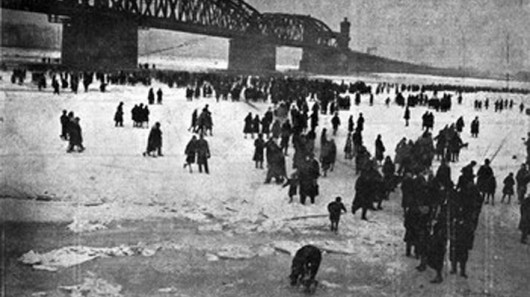Chilly European winters linked to solar activity
By Gizmag Team
August 27, 2012

The frozen Rhine river close to Mainz during the winter of 1962/1963 (Photo: Frank Sirocko)
Some clever cross-referencing has helped an international team of researchers establish a link between low periods of solar activity and frosty European winters. The Sun's level of magnetic activity follows an 11-year cycle. Peaks in this cycle pose a threat to telecommunications and electricity networks and it's long been suspected that there's a correlation between the opposite end of the cycle and extreme winters in Europe. A lack of historical average temperature data makes it difficult to confirm this link, but scientists have filled the gap by studying the comings and goings of 19th Century riverboats on the Rhine.
Average temperature records may not have been kept 200 years ago, but records of riverboat traffic on the Rhine were. When the river froze, the boating stopped.
Professor Dr. Frank Sirocko hit upon the idea of using proxy data on freezing rivers to trace patterns in solar activity when he attended a once 25-mile ice-skating race in the Netherlands that can only be held every decade or so during extremely cold winters.
Evidence of a river freezing makes for a simple yardstick: "Either there is ice or there is no ice," says Sirocko.
The Rhine is a big river, so when it freezes it's a solid indication that it's very cold.
Comparing boating records from 1780 to 1963 with the 11-year Solar cycle, the team found that ten of the fourteen big freezes in the region occurred during years of low solar activity. The scientists say this adds-up to a 99 percent chance that extremely cold winters in central Europe and low solar activity are linked.
"We provide, for the first time, statistically robust evidence that the succession of cold winters during the last 230 years in Central Europe has a common cause," says Sirocko.
The study adds to our knowledge of the role solar activity plays in the Earth's climate system, but the regional nature of the data and the complex interplay between this and other weather factors means it's only part of the puzzle.
"There is some suspension of belief in this link," according to Thomas Crowley, Director of the Scottish Alliance for Geoscience, Environment, and Society. "This study tilts the argument more towards thinking there really is something to this link. If you have more statistical evidence to support this explanation, one is more likely to say it's true."
"Climate is not ruled by one variable," says Sirocko. "In fact, it has at least five or six variables. Carbon dioxide is certainly one, but solar activity is also one."
The paper entitled Solar influence on winter severity in central Europe is published in the journal Geophysical Research Letters.
Source: Johannes Gutenberg-University Mainz
Copyright © gizmag 2003 - 2012 To subscribe or visit go to: http://www.gizmag.com
